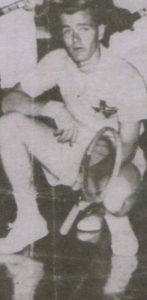James R. Callan's Blog, page 5
November 22, 2019
Be Inventive
November 14, 2019
What’s in a Name?
Have you read a book lately that had a character with an interesting name? Did you wonder where that name came from? Did the name just pop into the author’s head? Or was it an accident – that turned out to be fortuitous? Or is it a name that will become an icon of the future?
Suppose Margaret Mitchell had named her protagonist Jane. Would that have started the reader with a different impression than when she chose Scarlett? Before we even meet Scarlett we have a feeling about her. Scarlett reminds us of heat, emotion, energy, fire. We expect a fiery, energetic, volatile woman.
Do we start out with a different impression if the man guy is named Winston or Joe?
J.K. Rowling is one of the most successful writers of our time. Do you think she spent time on her characters’ names – and not just the major characters? And did they start us out with an impression? Draco Malfoy? Nymphadora Tonks? Ron Wesley? Servius Snape? Those names did not just trip off her tongue; she worked to come up with them. Why, with all those great names, did she name the protagonist a rather plain name – Harry Potter? Perhaps she wanted to give us the impression that he was an ordinary person, a reluctant hero.
The name is part of the character. Why do some people change their name in real life? Because they want a different persona, a different outward expression that better reflects how they feel about themselves, how they want to be viewed. So you, the writer who is creating this character, need to decide how the character views herself.
 In Deadly Additive, Donn Taylor named a secondary character who always operated on the edge, Brinkman. An accident? I don’t think so. Ian Fleming gave us some insight into the character of his antagonist in The Richest Man in the World when he named him Auric Goldfinger.
In Deadly Additive, Donn Taylor named a secondary character who always operated on the edge, Brinkman. An accident? I don’t think so. Ian Fleming gave us some insight into the character of his antagonist in The Richest Man in the World when he named him Auric Goldfinger.
Can the name mislead us? Certainly, if you want it to. Just don’t let it happen by mistake. Tiffany can be a person who spends her life helping the homeless, living and eating with them, and then returning to her one-room under the Elevated. Maybe her parents are rich and she was to be a debutant. But the girl wanted to do something more important.
You can use the name to help make the case for who this person is, or who the parents imagined she might be. Holly Golightly was a happy, carefree woman. Sam Spade was a straight forward, no-frills, hard-working person who dug for clues. 
Suppose your heroine is named Catherine. If she calls herself Cat, that tells us how she sees herself, and how the reader should view her.
Select the names of your characters carefully. Do not use the name as simply a way to distinguish one character from another. Make a conscious effort to select a name that helps build your character.
You work hard to give your book a name that will entice the reader to pick it up and read. Select your character name to make that character and your book memorable.
I’d love to hear your comments on your favorite names in books.
October 30, 2019
Free Ice Water
To those of you who have been with me for seven years, I apologize. But the other day, a friend ask me to reprise this blog. So here it is. It still has merit today.
On a recent road trip, we passed through Wall, South Dakota, and visited Wall Drugs. That’s almost all there is in the small town. But, it is something to see. It now fills a square block, and claims to be the largest drug store in the country. I have no doubt it is. It has many, many rooms for various items that might tempt a tourist to part with some dollars, play areas for kids, some excellent art, and a restaurant that can handle 500 people at a time. Oh yes, there is a pharmacy, but it is almost lost among the opportunities to buy just about anything.
You have no trouble finding Wall Drugs. For a hundred miles east and west you will see signs along the highway for Wall Drug Store. Many of them simply say, “Free Ice Water. Wall Drug Store.”
Today, with our air-conditioned cars and fast food places every ten minutes, free ice water doesn’t seem to be much of a draw. But back in 1931, things were different.
In 1931, the owners of Wall Drugs, a young pharmacist and his wife, were about to give up that hot summer. They had agreed they would give it five years and if they couldn’t make it in that period, they’d pull up stakes and move to a big city. Their five years were almost up.
One hot day, the pharmacist’s wife came in and said she had an idea that might get some of the people driving down the highway to stop and come into the store. What did people really want on a hot summer day driving in a hot car through a dusty area? Ice water. She suggested putting up signs on the highway that said, “Free Ice Water.”
The pharmacist and a high school boy drove out and put up the signs. Before they got back, cars were stopping and people were asking for free ice water. Some of them decided to get ice cream. And some bought other things. Business began to grow. By the next summer, they had to hire eight girls to handle the sales.
In 2012, a good day will see 20,000 people come through the Wall Drug Store. The highway signs advertise many items sold at Wall Drugs. But many of the signs still read, “Free Ice Water. Wall Drug Store.” And “5 Ȼ Coffee, Wall Drug Store.” Yes, when you get there, you can get free ice water and you can still get a cup of coffee for 5 Ȼ. But the customers spend much more than a nickel. The same family still owns the store, although it has passed on to the children and grandchildren of the original couple who found a way to bring business into their store.
How did they do it? They found what people really wanted and provided it. But, it was the simple signs that brought the people in. As writers, we need to decide what it is that people really want in a book. We must then provide it. But the big step is to advertise it. Let people know that what they want is available. The difference is that today, we will put our signs on the Internet highway. People cruise down it every day, twenty-four hours a day. We must get our signs out there. Simple, to the point signs, that offer the public what they want. Maybe we give something away. It might be a first chapter. It might be a drawing for a free book. (You can’t afford to give a book to everybody.) Maybe it only needs to be a very short blurb that entices the passerby to stop for a moment, read a bit more, maybe decide to buy.
The key is to provide what the public wants, and tell them about it so they can pass the word around.
One last thing. You’ll notice I didn’t say “readers.” We might as well aim for a larger group. Write a book that will bring more people into the reading community. Expand our fan base. Find today’s “Free Ice Water” and put out those signs on the highway.
And today, I’d appreciate a comment as much as a glass of ice water. Thanks.

On Amazon in digital, paper, or audio formats: https://amzn.to/2UDjXxw
October 11, 2019
Designing the Book Cover
Today’s guest blogger is Elaine Faber, a member of Sisters in Crime, Cat Writers Association, and Northern California Publishers and Authors. She lives in Northern California with her husband and two housecats. Elaine leads two writer’s critique groups and enjoys working with other talented authors.
Winner of multiple awards for her short stories and novels, she pens a series of cozy cat mysteries and a series of humorous WWII mystery/adventures. She has published seven novels and an anthology of short stories highlighting the lives of cats. Fourteen additional anthologies include her humorous tales
she pens a series of cozy cat mysteries and a series of humorous WWII mystery/adventures. She has published seven novels and an anthology of short stories highlighting the lives of cats. Fourteen additional anthologies include her humorous tales
Here are her comments on getting the cover right.
There are as many ways to design a book cover as there are books. Nonfiction book covers, particularly political books seem to lean toward THE TITLE against a plain background and the author’s name. Many cozy mystery novels present an artist’s rendition of a house and garden, often including a dog or cat.
I prefer using photographs on my book covers. The book cover should suggest the plot. If the book is part of a series, there should be consistency in the design. Using the same color and size font for the title and a similar design helps readers recognize a particular series.
I just published the fourth cozy cat mystery. Black Cat and the Secret in Dewey’s Diary is a dual tale that takes place in California and also in Austria. While Black Cat and Angel are embroiled in village intrigue and riveting drama along the shores of a No. California resort town, Dorian and Kimberlee seek a long-lost treasure they believe is still hidden in Hopfgarten, Austria. The story moves back and forth between Black Cat’s wisdom and Angel’s snarky wit in Fern Lake, and Kimberlee’s unexpected challenges facing a stalker in a foreign country.
It all started with a message in a WWII diary from a soldier who befriended a German soldier during the battle of Normandy. Following the war, Dewey receives and records in his diary, a mysterious message from his friend… The treasure is in Hopfgarten….touch the feet of the babe…
Kimberlee reads Dewey’s diary just before she and Dorian embark on an Austrian vacation. Of course, they must go to Hopfgarten to follow the clues to a treasure missing for more than 50 years.
Kimberlee’s Austrian adventure includes many of my own 1987 personal experiences when I traveled through castles and villages, saw cows wearing bells around their necks, visited 1000-year-old churches in Salzburg, and finally into Hopfgarten where I experienced many of the events included in Kimberlee’s adventure, and first imagined the story of a missing treasure and Dewey’s diary.
Finding the right photographs for my Black Cat mystery was time-consuming. I wanted the photos to suggest both parts of the story. It had to include a cat with his foot on a diary to suggest that important plot point. It must also suggest the European half of the story. There are plenty of Europe castles available on Fotolia and Shutterstock, but the search was on for the right black and white tuxedo cat.
I requested photographs from an online cat group, of black and white cats with their paw raised,so a diary could be photo-shopped under it. I received over 100 lovely pictures. However, another picture was eventually chosen from Shutterstock.
I think my readers will enjoy this new and latest exciting Black Cat adventure, Black Cat and the Secret in Dewey’s Diary. Let me know how you feel about a book with basically two stories interwoven throughout.
Black Cat and the Secret in Dewey’s Diary at:
http://tinyurl.com/y2tyyeh5 ($3.99 e-book)

(Dewey’s diary Back Cover blurb) In this dual tale of mystery, lost treasure, and riddles, while Black Cat narrates the exciting events in Fern Lake, Kimberlee discovers a cryptic clue in a diary about a hidden treasure, and heads to Austria to solve the puzzle.
When Kimberlee and Dorian arrive in Austria, they attract the attention of a stalker determined to steal the diary in hopes the clues will lead him to the treasure first. On a collision course, it is inevitable that Kimberlee and the stalker meet in Hopfgarten.
Black Cat and Angel’s lives are endangered with the arrival of Kimberlee’s grandmother in Fern Lake, and the return of a man presumed dead for twenty-five years. With both arrivals, emotional and financial difficulties loom for Kimberlee’s family.
Since their return to Fern Lake, Angel seems reluctant or unable to adjust to her new home. Does she regret leaving Texas and Grandmother? And, when the opportunity arises, will she decide to leave Black Cat and Fern Lake?
August 19, 2019
Just to make you smile
This was just too good to miss. Here is a sign I found today and I think it should appeal to all writers.
 Have a great day. And please note: studies show that a good laugh every day improves not only your health, but your brain as well.
Have a great day. And please note: studies show that a good laugh every day improves not only your health, but your brain as well.July 26, 2019
We’re All Two Halves of the Same Cookie
Today, we’re hosting an eclectic artist and author, Carol McClain, who is also secretary of the Author’s Guild of Tennessee. She’s a transplant from New York, but more on that later. She has published five books and currently does a little blogging. Welcome Carol McClain and read a little sage wisdom gained from her time in New York and her time in Tennessee.
Carol McClain, who is also secretary of the Author’s Guild of Tennessee. She’s a transplant from New York, but more on that later. She has published five books and currently does a little blogging. Welcome Carol McClain and read a little sage wisdom gained from her time in New York and her time in Tennessee.
You’ve seen black and white cookies, those giant confections whose frosting is equally divided between “chocolate” and “vanilla.”
As a child, I loved them. Being female, and a moody one at that, I always claimed the chocolate side when my mother bought them. (We had to share).
As an adult, I one day discovered a display of them. I indulged and bought one.
I nibbled the chocolate side—no need to share as I paid my grown-up money for it. I discerned no chocolate flavor. I chomped into the vanilla side. It tasted like the same—maybe with a slight variation. Both sides of the black and white cookie could’ve been one color.
One day, after several years of debating, my husband and I decided to move from northern New York to the warmer climes of East Tennessee. A writing friend became excited. “Write one of your funny books about the differences between the North and South.”
As I packed for my move, I envisioned the novel. With the animosity between the North and South, with geopolitical and social differences, I’d have an hysterical story.
We moved to Campbell County in the heart of the Cumberland Mountains and discovered, like the black and white cookies, with only slight variations, no differences existed.
There went my book idea.
Still, my friend nagged while I settled in.
Cornbread, a hill dialect, a culture of Christianity as opposed to a culture of agnosticism were about the only variations I found. It confirmed something I believed.
 Liberalism mimics conservativism. It, too, excludes things it doesn’t believe in. Blacks/whites, Russians (my heritage)/Anglo Saxons, Baptists/Evangelicals, gay/straight, we all vary outwardly like the icing on the pastry, but as Mandissa sings, “We all bleed the same.”
Liberalism mimics conservativism. It, too, excludes things it doesn’t believe in. Blacks/whites, Russians (my heritage)/Anglo Saxons, Baptists/Evangelicals, gay/straight, we all vary outwardly like the icing on the pastry, but as Mandissa sings, “We all bleed the same.”
In the end, I found my book. A New York Yankee on Stinking Creek explores the difference between the North and the South. And nothing’s as it appears, and the extremes of anything err.
We are human. We are sinners. We need redemption. We’re two halves of a black and white cookie.
Carol enjoys running, jazz, stained glass and, of course, writing. She is the President of ACFW Knoxville. The world in East Tennessee intrigues her from the friendly neighbors to the beautiful hiking trails and the myriad wildlife.
NOTHING GOOD COMES FROM STINKING CREEK
Alone, again, after the death of her fiancé, abstract artist Kiara Rafferty finds herself on Stinking Creek, Tennessee. She wants out of this hillbilly backwater, where hicks speak an unknown language masquerading as English. Isolated, if she doesn’t count the snakes and termites infesting her cabin, only a one-way ticket home to Manhattan would solve her problems.
Alone in a demanding crowd, Delia Mae McGuffrey lives for God, her husband, her family, and the congregation of her husband’s church. Stifled by rules, this pastor’s wife walks a fine line of perfection, trying to please them all. Now an atheist Yankee, who moved in across the road, needs her, too.
Two women.Two problems. Each holds the key to the other’s freedom.
A New York Yankee on Stinking Creek, on Amazon in print and digital at https://tinyurl.com/y2pxjt4a
July 14, 2019
I didn’t die, but . . .
 That was just the start. Apparently there had been an incredible amount of rain. And then strong, erratic winds. Many live trees were toppled, simply uprooted. These ranged from 100-foot tall pines to old oak trees.
That was just the start. Apparently there had been an incredible amount of rain. And then strong, erratic winds. Many live trees were toppled, simply uprooted. These ranged from 100-foot tall pines to old oak trees.

When I cut through one of the oak trees and counted the rings, it was about 60 years old.

I still don’t know exactly how many huge trees came down – more than I have managed to clean up so far. But, I’ve taken on the role of lumberjack. And not being Paul Bunyon, it’s taking me awhile. Good exercise. Next week, I’m back on the computer, at least for a few hours. I feel another book wanting to hit the pages.

Thanks for putting up with my rambling. I’ll stop – and go crank up the chainsaw.
jim
May 24, 2019
The Glamorous Life of a Writer
Today, writer and international speaker Jennifer Slattery talks about  the glamorous life of a writer. It’s a fun read and maybe we can see ourselves in the title role. Jennifer has published six contemporary novels, maintains a devotional blog, and works on several fronts to help women realize their true worth. But now, here is that glamorous life.
the glamorous life of a writer. It’s a fun read and maybe we can see ourselves in the title role. Jennifer has published six contemporary novels, maintains a devotional blog, and works on several fronts to help women realize their true worth. But now, here is that glamorous life.
Whoever writes authors into movies have never met any in real life. At least, they’ve never met this writer.
Considering all my mishaps, I should probably write romcom.
A few summers ago, threw away my favorite black pair, fully intending to replace them. Once I finished that story, then that article, then that next blog post …
Mid-August rolled around, and I began packing for what I knew would be a whirlwind trip–a conference where I’d be speaking and teaching three classes, followed by a book signing, with a day and a half home before heading to an author event followed by another conference.
So there I was, planning what to wear and … no black flats, and no time to hit the mall. Luckily (ha!) our daughter, who was still living with us at the time, owned a really cute pair of pumps, so I tossed them in my suitcase, closed it up, and was good to go.
Eh …
Saturday rolled around, the last day of the conference and the day of my book signing. By this point, I was also down to one outfit–the one needing those black pumps. So, on they went.
And I quickly remembered how long it’d been since I’d worn heels. And that my daughter’s feet are wider than mine. So here I am, trying to look all professional while wobbling around, about ready to topple over, in my daughter’s much too high heels. To make things worse, every third step one of my shoes actually slipped off, nearly sending me flat on my face.
All while I was trying to act all bookishly professional–and everyone I encounter, including the bookstore owner hosting me, is doing there best not to laugh out loud.
Grown woman, acting like a teenager in her first pair of heels. Oy.
I wish I could say wardrobe malfunctions during book signings are rare events, but …
I was on another trip, this time in Des Moines. Once again, it was a whirlwind weekend with back-to-back speaking engagements followed by a signing. By my last event, I was down to my last outfit–the one I was wearing. The others were not so neatly packed in my suitcase in the trunk. Add to this the fact that it was freezing out–not sure capris and strappy sandals were a great idea.
With goosebumps exploding across my arms and my lips turning a deep shade of blue despite my heavily applied lipgloss, I decided to buy some coffee.
Did I mention I was wearing white capris? You know where this is going, don’t you? I experienced a momentary rush of warmth, followed by a rush of panic.
A writer’s life. Isn’t it glamorous?
Do you have any wardrobe fails to share? It would make me feel better. Seriously.
May 3, 2019
The Story Behind the Story
This week’s guest blogger is June Foster, an award-winning author who began her writing career in an RV roaming around the USA with her husband, Joe. She brags about visiting a location before it becomes the setting in her next contemporary romance or romantic suspense. To date, June has 17 novels published.
who began her writing career in an RV roaming around the USA with her husband, Joe. She brags about visiting a location before it becomes the setting in her next contemporary romance or romantic suspense. To date, June has 17 novels published.
Dreams Deferred is inspired by the true-to-life story of my great grandfather and great grandmother. I chose to set it in contemporary times. Nevertheless, I borrowed many of the story elements from the true story.
Frances Mathew Halbedl grew up in the European Austrian Empire and followed tradition in which the oldest son became a priest in his family’s Catholic faith. After being ordained in Moravia, he immigrated to the United States in 1866 to serve in a parish in the state of Louisiana.
 My aunt and mother always told the story of how one Sunday while saying mass, he spotted a young teen, much younger than my Mary Louise. He waited several years for her to grow up then stepped down from the priesthood to marry her. I wish I knew some of those rich details of their courtship, but since I don’t, I fictionalized their romance.
My aunt and mother always told the story of how one Sunday while saying mass, he spotted a young teen, much younger than my Mary Louise. He waited several years for her to grow up then stepped down from the priesthood to marry her. I wish I knew some of those rich details of their courtship, but since I don’t, I fictionalized their romance.
They later moved to San Antonio, Texas, and had five children, three girls and two boys—Ida, Mamie, Alice, Roy, and Clifton, who was my grandfather. Just for fun in one scene, I imagined that Matt had a dream he was riding in a car with Mary Louise and the three youngest kids. In my story, the dream helped him realize how much he loved Mary Louise.
Mathew taught music both in the public school and privately. Later he became the first principal of a high school in San Antonio. In December of 2005, my husband and I visited San Antonio and looked up Matthew and Mary Louise’s house. The large, two-story home is still there on Roseborough Drive. We weren’t able to go in because it’s a private residence. But I had so much fun envisioning Matt and ML’s lives as they lived there with their children.
We also visited Clifton Halbedl’s home, which I remember from childhood. I also had the address for Mamie’s home, and we were able to go inside. A gracious lady who spoke no English invited us in. I have tons of pictures and hope to share them on my blog.
In the story, Matt gets a job at Jefferson High School. This is patterned after Thomas Jefferson High School where my mother went to school. Her name was Mary Louise, as well, named for her grandmother.
If I’ve learned anything from writing this book, I wish I’d probed for more information when my mother and aunt were still alive, but I’m grateful for what I do know.
Brief Blurb on Dreams Deferred –
Father Matt Hall wants to serve the Lord. School teacher Mary Louise Graham needs freedom from her unforgivable past. They never expect to fall in love.
You can find June at: junefoster.com.
You can find Dreams Deferred at: https://tinyurl.com/y3g555tz
April 22, 2019
The Conclusion of “Double Faults and a Wart”
If you didn’t read the first part of this true-life story from my past, I recommend you read it now. To get the real magic of this story, you need to read the first post — first. It should be on this site. Just scroll down past this post and there it is.
Chapter Two.
Fast forward seven months.
 My mother and I were doing some Christmas shopping one day before Christmas (of course). Here, I do not mean “one day” as the day before Christmas, but “one day” as in “a single day.” We had bought an item at the Harris store in Oak Cliff. While we waited for the sale to be processed, I let slip a complaint about the wart on my finger. Perhaps I had served a double-fault the day before, or some other wart-induced calamity. But I did complain about my wart.
My mother and I were doing some Christmas shopping one day before Christmas (of course). Here, I do not mean “one day” as the day before Christmas, but “one day” as in “a single day.” We had bought an item at the Harris store in Oak Cliff. While we waited for the sale to be processed, I let slip a complaint about the wart on my finger. Perhaps I had served a double-fault the day before, or some other wart-induced calamity. But I did complain about my wart.
The saleswoman reached over the counter and took my hand in hers. She was as old as my mother, so I was not unduly alarmed. I wasn’t even duly alarmed. She turned my hand over in hers, looked at the wart, and began gently to rub it with one of her fingers. I do not remember which of her fingers she used, nor whether she rubbed in a circular motion or a linear motion. But she rubbed my left index finger, or more accurately, she rubbed the wart on my finger.
This happened rather quickly and she rubbed for no more than a few seconds. And as she rubbed the wart, she said, “I believe it will go away.”
Outside, walking to the car, my mother and I joked about the incident. It was harmless enough. She seemed like a nice lady, and was not offended by the double-fault-provoking growth.
Being well-read, I had heard of medicine men removing a wart by rubbing it with a seven-year-old rag, hand-woven of flax and soaked in garlic oil, and afterward burying the rag in the ground during a three-quarter moon and at such a point that the morning shadow of a cedar tree would cover the burial spot. I found no documentation to indicate that those results lasted any better than the scissor snipping did.
A week later, the wart was gone. Vanished. No special care required. No scissors. No queasy stomach. No wart. No double-faults.
A year later, the wart was gone. Two years later, the wart was gone. Twenty years later, the wart was still gone.
The saleswoman could have been an out-of-work witch doctor making some money by working the Christmas rush. She may have been a skilled surgeon doing some pro-bono work, or perhaps testing a new procedure on unsuspecting strangers. I could have been the subject of some undercover testing not approved by the AMA or the NIH or the CIA.
Of course, Harris would not reveal the identity of the sales clerk. Mysteriously, personnel records for part-time Christmas workers for that year were lost, destroyed by a freak fire which burned only a tiny section of their files. (This was, as you know, long before computers captured everything and never lost a file.) Thirteen private-eyes (seven PI’s, one with only one eye) could find no trace of the mystery woman. And I could find no trace of the wart. So, after years, I abandoned the search. For either one.
Today, the wart is still gone. The only thing on the pad of my left index finger is a tiny scar—the result of a pair of scissors.
And that’s the story of double faults and a wart. I was just a couple of years out of college and it happened pretty much as I described it in these two posts. I hope you enjoyed this glimpse into my earlier life, and how shamans (though she did not enter a trance) or grandmothers (or perhaps even an alien) can outperform the medical industry at times. Leave me a comment and let me know if you think this could be the centerpiece of my memoir. And thanks for your patience.
James Callan, wart-free ex-tennis player



